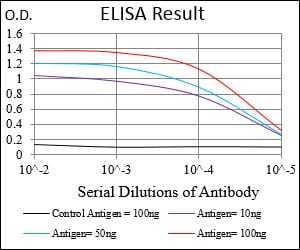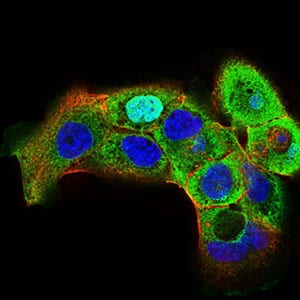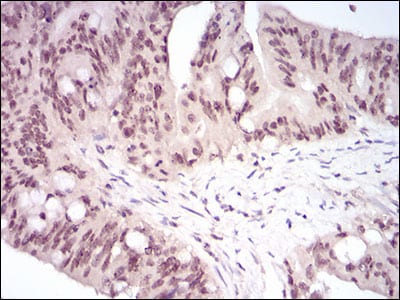


| WB | 咨询技术 | Human,Mouse,Rat |
| IF | 咨询技术 | Human,Mouse,Rat |
| IHC | 1/200 - 1/1000 | Human,Mouse,Rat |
| ICC | 1/200 - 1/1000 | Human,Mouse,Rat |
| FCM | 咨询技术 | Human,Mouse,Rat |
| Elisa | 1/10000 | Human,Mouse,Rat |
| Aliases | HSTF1 |
| Entrez GeneID | 3297 |
| clone | 4D5F4 |
| WB Predicted band size | 57.3kDa |
| Host/Isotype | Mouse IgG2b |
| Antibody Type | Primary antibody |
| Storage | Store at 4°C short term. Aliquot and store at -20°C long term. Avoid freeze/thaw cycles. |
| Species Reactivity | Human |
| Immunogen | Purified recombinant fragment of human HSF1 (AA: 256-359) expressed in E. Coli. |
| Formulation | Purified antibody in PBS with 0.05% sodium azide. |
+ +
以下是关于HSF1抗体的3篇代表性文献及其摘要内容概括:
1. **文献名称**:*HSF1: Guardian of Proteostasis in Cancer*
**作者**:Dai, C., Sampson, S.B.
**摘要**:该研究探讨了HSF1在肿瘤发生中的作用,通过HSF1抗体进行染色质免疫沉淀(ChIP)实验,发现HSF1通过调控热休克蛋白(HSPs)和代谢相关基因,促进癌细胞的存活和增殖。
2. **文献名称**:*Heat shock factor 1 is a powerful multifaceted modifier of carcinogenesis*
**作者**:Whitesell, L., Lindquist, S.L.
**摘要**:文章利用HSF1抗体进行免疫印迹(Western blot)和免疫组化分析,揭示HSF1在多种癌症中异常激活,并通过调控应激应答通路影响肿瘤微环境及耐药性。
3. **文献名称**:*Regulation of HSF1 function in the heat stress response*
**作者**:Akerfelt, M., Morimoto, R.I., Sistonen, L.
**摘要**:研究通过HSF1抗体检测其在热应激条件下的磷酸化状态,阐明HSF1的激活机制及其与分子伴侣的相互作用,为靶向HSF1的疾病治疗提供依据。
4. **文献名称**:*HSF1 phosphorylation establishes a stress-responsive chromatin state*
**作者**:Guettouche, T., Boellmann, F., et al.
**摘要**:使用HSF1特异性抗体进行免疫荧光和流式细胞术,发现HSF1的磷酸化修饰调控其核转位及DNA结合能力,进而影响应激相关基因的转录活性。
这些文献均涉及HSF1抗体的实验应用,涵盖癌症、应激反应调控及分子机制等领域。如需具体年份或期刊信息,可进一步补充。
The heat shock factor 1 (HSF1) antibody is a critical tool in studying the molecular mechanisms of cellular stress responses. HSF1. a transcription factor, is the master regulator of heat shock proteins (HSPs), which are molecular chaperones essential for protein folding, particularly under stress conditions such as heat, oxidative stress, or proteotoxic insults. HSF1 antibodies are widely used to detect and quantify HSF1 expression, localization, and activation status in various experimental models, including Western blotting, immunofluorescence, and chromatin immunoprecipitation (ChIP).
HSF1 exists in a monomeric, inactive state under normal conditions but forms trimers upon stress, translocating to the nucleus to bind heat shock response elements (HSEs) in target gene promoters. Post-translational modifications (e.g., phosphorylation, acetylation) regulate its activity, making phospho-specific HSF1 antibodies valuable for studying activation dynamics. Dysregulation of HSF1 is implicated in cancer, neurodegenerative diseases, and aging, driving interest in therapeutic targeting.
Available as monoclonal or polyclonal versions, HSF1 antibodies vary in specificity and applications. Validation via knockout cells or siRNA knockdown is crucial to confirm target specificity. Researchers also utilize these antibodies to explore HSF1’s non-canonical roles in metabolism, development, and immune responses, highlighting its broad biological significance beyond heat shock regulation.
×